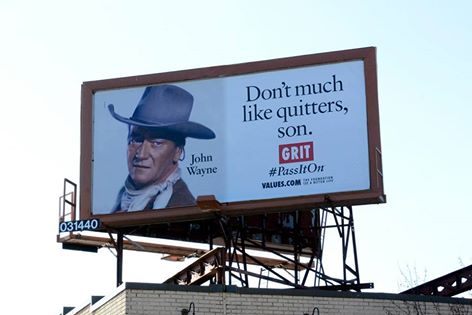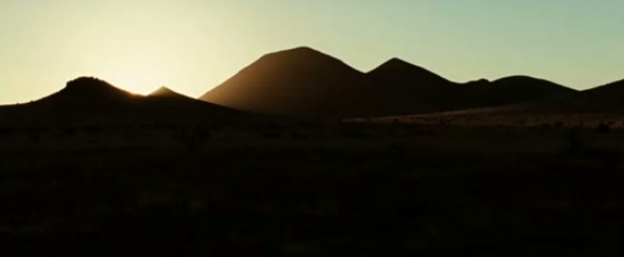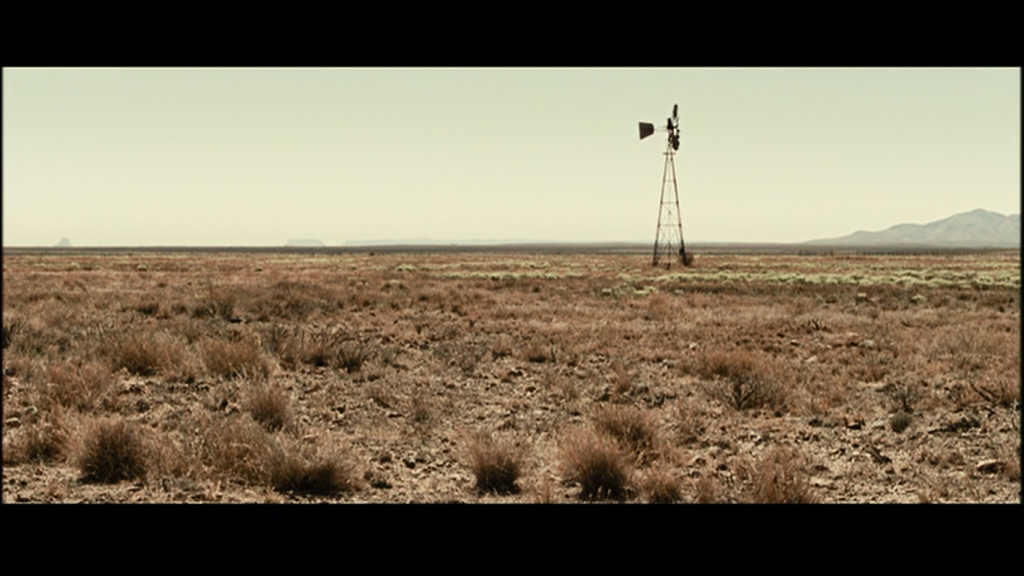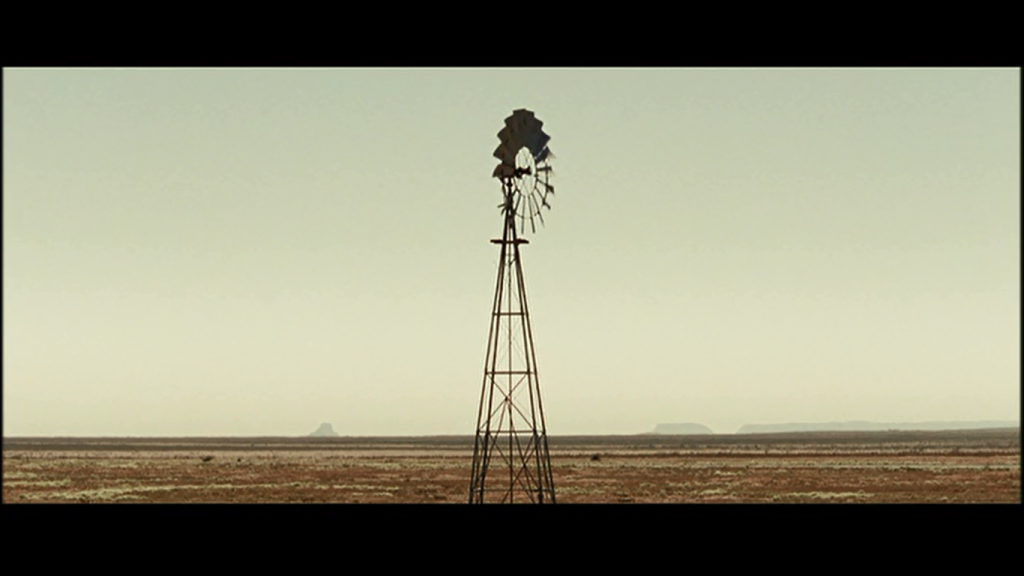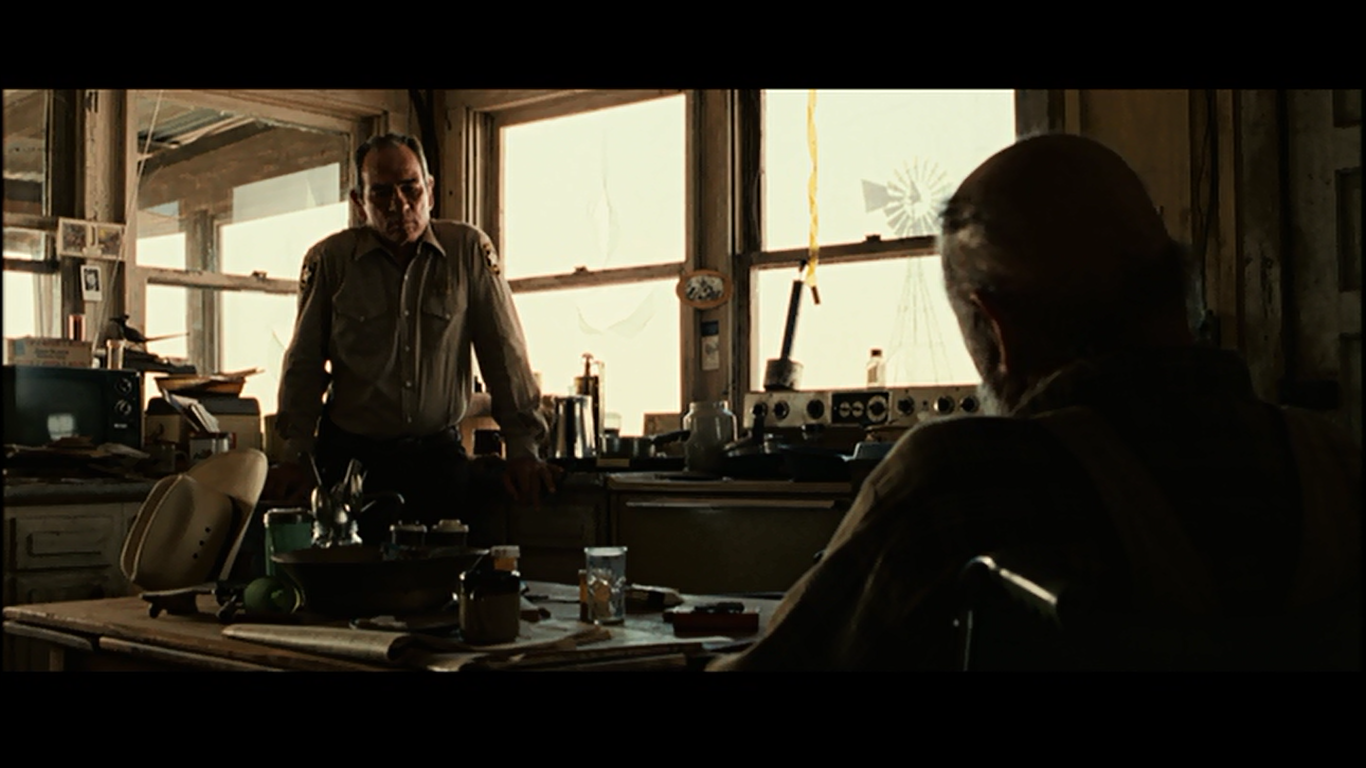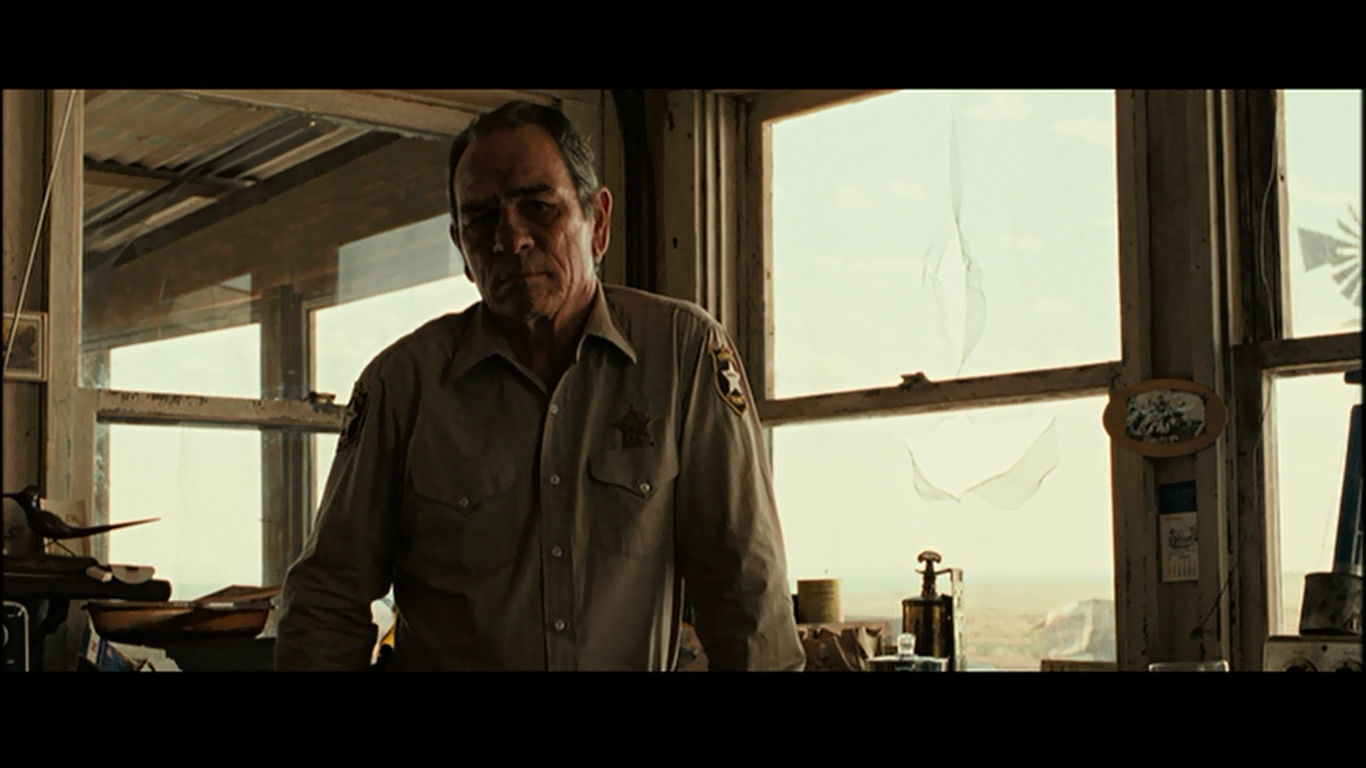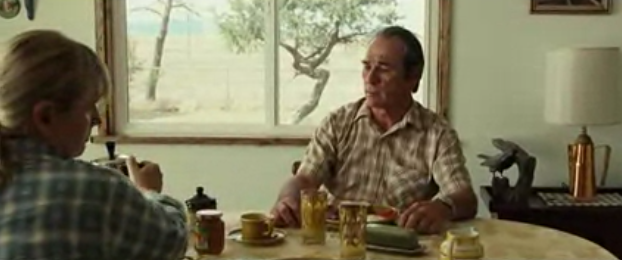Girls and old men talking: gender, power, and sound in the coen brothers’ no country for old men and true grit
Laura L. Beadling
Recently in my neighborhood, a new billboard went up. It’s part of the “Pass It On” series of billboards put up by The Foundation for a Better Life, an organization that purports to “model the benefits of a life lived by positive values.”[1] These billboards are probably familiar to many, as the foundation has so far put up 10,000 of them across the country.[2] This particular billboard features an image of John Wayne in full Western gear, including Stetson hat and neckerchief, with the quote “Don’t much like quitters, son” and the word grit.
This billboard, with its valorization of Western icon John Wayne and its male speaker addressing a male audience (“son”), caught my attention in no small part because of my current work on gender, voice, and sound in the Coen brothers’ films No Country for Old Men (2008) and True Grit (2010), which is a remake of the Henry Hathaway version of Charles Portis’s novel of the same name. Hathaway’s 1969 film starred John Wayne, icon of American Western masculinity. The “value” highlighted by this billboard, “grit,” of course references Rooster Cogburn, the character played by Wayne in True Grit, chosen by Mattie to avenge her father’s death, expressly for his grit.
Hathaway’s True Grit, like other classic westerns, portrays a “world whose heroes—cowboys, gunslingers, sheriffs, prospectors, trappers, ranchers, buffalo hunters, bullwhackers, mountain men, rodeo riders, and homesteaders—are white American Protestant males.”[3] The liberties it took in adapting Portis’s novel significantly shifted the focus from Mattie onto Rooster/Wayne, cementing the film’s association with the “ideal, patriotic, conservative manhood” embodied by John Wayne.[4] Wayne’s brand of masculinity supports Andrew Spicer’s claim that “successful, competitive individualism” remains the “core American masculine myth,” a myth that continues to echo across the U.S., as the 2015 billboard attests.[5]
While there is no sustained analysis of genre covering the Coen oeuvre, many critics have noted that “genre subversion” is a Coen trademark, and several examine the genre complexities of specific Coen films.[6] In particular, The Big Lebowski, because of its exuberant genre combining, has excited much generic scholarship. For instance, J. M. Tyree and Ben Walters assert that “The Big Lebowski is not just the story of a ransom gone wrong, it’s also a case study in genre gone wrong, genre gone wild, gone fishing, or gone bowling.”[7] R. Barton Palmer characterizes The Big Lebowski as “postmodern pointlessness, with its wacky mixture of genres.”[8] In contrast, Allen H. Redmon pointedly asserts that the film “amounts to more than the generic allusion or parody” and argues for a “constructivist use of genre” that allows viewers to participate in creating the narrative depending on which genre lens is chosen.[9]
While The Big Lebowski has received the most robust genre analysis, many critics have more generally noted references to the Western genre in many Coen films, including The Big Lebowski, Raising Arizona, and Blood Simple, as well as the more obvious heirs, No Country for Old Men and True Grit. The Coens deploy their trademark genre mixing throughout these films, with only True Grit being a Western in the classical sense. Whereas critical commentary surrounding True Grit has recognized it unanimously as a Western, No Country has engendered less definitive generic classification, although many, including William J. Devlin[10] and Camilla Fojas, call it a neo-Western, most often because of its setting in Texas and its inclusions of a Sheriff and a hardscrabble loner cowboy.[11] Sonya Topolnisky notes that “the actors and the Coen brothers themselves have difficulty classifying No Country for Old Men, using the terms chase, horror, comedy, Western, and noir interchangeabl[ly]” while she herself argues that No Country has “a strong family resemblance to the [Western] genre through its preoccupation with violence and masculinity.”[12]
While feminist critics have noted the rich and iconoclastic characterization of Marge Gunderson, the pregnant sheriff from Fargo (1996), a sustained consideration of gender roles in the Coen films remains undeveloped. A focus on gender informs my essay, as I explore, in particular how No Country for Old Men and True Grit present characters that challenge the longstanding gender traditions of the Western. And more precisely, I will suggest that sound plays a key role in the films’ reconfigurations of gender in the Western.
Both No Country for Old Men and True Grit are neo-Westerns that undermine the typical gender hierarchy present in most classical Westerns through complex uses of voice-over narration and sound. Each film includes the Coens’ trademark violence and stylistic flair, but equally important to their unique style is a particular use of voice-over narration and an investment in subverting not only genre but gender expectations. Kaja Silverman has commented on classic cinema’s tendency to hold “the female voice and body insistently to the interior of the diegesis, while relegating the male subject to a position of apparent discursive exteriority by identifying him with mastering speech, vision, or hearing.”[13] In their re-imagining of the classic western genre, the Coens confront precisely this tradition of aggrandizing the male voice that Silverman identifies. Specifically in No Country, the male voice-over narrator moves from a disembodied position of power and authority to an embodied position of impotence, while in True Grit it is Mattie Ross’s voice that transcends the diegesis and provides the lens for understanding the story and its meaning. Both No Country and True Grit recast issues of gender and sound to critically reflect upon the place and meaning of the Western.
Sound, Music, and Voice in No Country for Old Men
No Country’s soundtrack is quite unusual in several ways. Most noticeably, there is very little music; out of its running time of 122 minutes, there are only 16 minutes of music, most of which come over the ending credits. What music there is during the film itself is mostly droning and non-melodic, typically introduced underneath the sound of a motor and thus almost imperceptible. Instead of music, the dominant presences on the sound track are voices, especially voice-over narration, and sound effects, including motors and other car sounds, gunshots, and, most importantly, the wind. The lack of music gives the sound effects and the voice room to shine, and they do, not only in enhancing realism, but also in furthering the narrative and deepening its thematic significance.
While the soundtrack is often conceived of as enhancing the realism of a film narrative, in No Country, the sound and image tracks clash in several places. Silverman argues that “Insofar as the voice-over asserts its independence from the visual track, it presents itself as enunciator. It seems, in other words, to be a metafictional voice, the point of discursive origin,” and No Country at first seems to follow this aesthetic.[14] Bell’s voice-over narration begins on a black screen, before images fade in; as he speaks, the first few images depict extreme long shots of the landscape at daybreak, which then proceeds through the early morning hours. In one shot, the sun literally rises over a distant mountaintop. Bell’s voice is calm, authoritative, and absorbing as he reflects upon what it means to be a third-generation sheriff.
This initial appearance of authority and power, however, is undercut in several ways as the film continues. Mary Ann Doane argues that a voice heard in voice-over narration “is not localizable” and, because “it cannot be yoked to a body . . . it is capable of interpreting the image, producing its truth,” and this seems to be true of Bell’s opening narration, in which he claims authority over his county and proudly notes that he’s been sheriff there since he was twenty-five years old.[15] While Bell’s voice-over narration at first seems to embrace this power of enunciation, he soon admits his lack of knowledge and certainty, particularly concerning a murderous young man Bell arrested and sent to death row. After describing the boy’s lack of remorse or passion, Bell baldly confesses “I don’t know what to make of that, I surely don’t,” and continues by saying that there’s crime and violence today that is so inexplicable that it’s “hard to even take its measure.” During the ending of Bell’s monologue, when he is discussing the murderous young man, the image track begins to zero in on a windmill. Bell’s monologue plays under the first eleven shots of the film, most of which are extreme long shots of the empty landscape. Three shots towards the end of this sequence, however, are medium long shots and long shots of a windmill. As the voice-over dominates the sound track, the windmill comes to dominate the visual track; there is simply nothing else to listen to or look at.
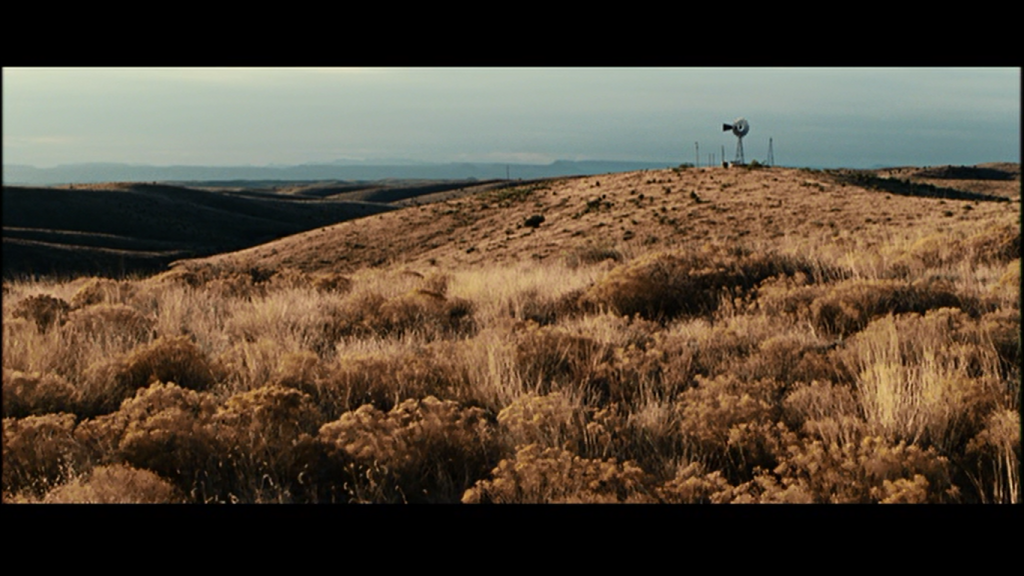
Windmill, shot 1. As the voice-over dominates the sound track, the windmill comes to dominate the visual track.
This intrusion of the windmill into the sheriff’s voice-over offers an illuminating instance of counterpoint between the image and the sound. The circular, endlessly spinning, man-made windmill evokes the endless cycle of human violence, calling into question Bell’s assertions that crime and violence are radically different today; its ceaselessly spinning wheel implies that crime and violence are constant and unchanging, as impossible to stop as the wind, which is heard on the soundtrack almost incessantly throughout the film. Not only does the sound of the wind come before Bell’s voice-over narration, but it is the only sound that plays throughout his voice-over; most of the images in the voice-over montage also show the wind moving grass and tree branches as well as the blades of the windmill. From the first moments of the film, the sound effect of the wind is, like the movement of the windmill blades, unchanging and unceasing, much as the film implies of human violence and evil.
Later in the movie, Bell visits his disabled Uncle Ellis, also a law enforcement officer, now retired, and this scene reinforces the above reading of the image track, which belies Bell’s voice-over. Although Bell grandiosely glorifies “old timer” lawmen in his opening voice-over narration, Ellis, an actual older lawman, is distinctly non-glorified. Living by himself with a crowd of half-feral cats, drinking rancid coffee, confined to a wheelchair in a tiny isolated shack, Ellis defies Bell’s vision of old timers who never even had to carry a gun, such was their personal authority. Bell confesses to a love of hearing stories about the old timers and to measuring himself against their legends. Ellis does not play along with Bell’s romanticized visions, however, and he flatly tells Bell “what you got ain’t nothing new.” He relates a story of one of their relatives who was shot in his own doorway by pitiless men.
As Ellis refuses Bell’s self-characterization as a lawman overmatched by the evil in the contemporary world, the camera depicts a shot of Bell looking out Ellis’s window, where he sees a windmill much like the one showcased during Bell’s opening voice-over.
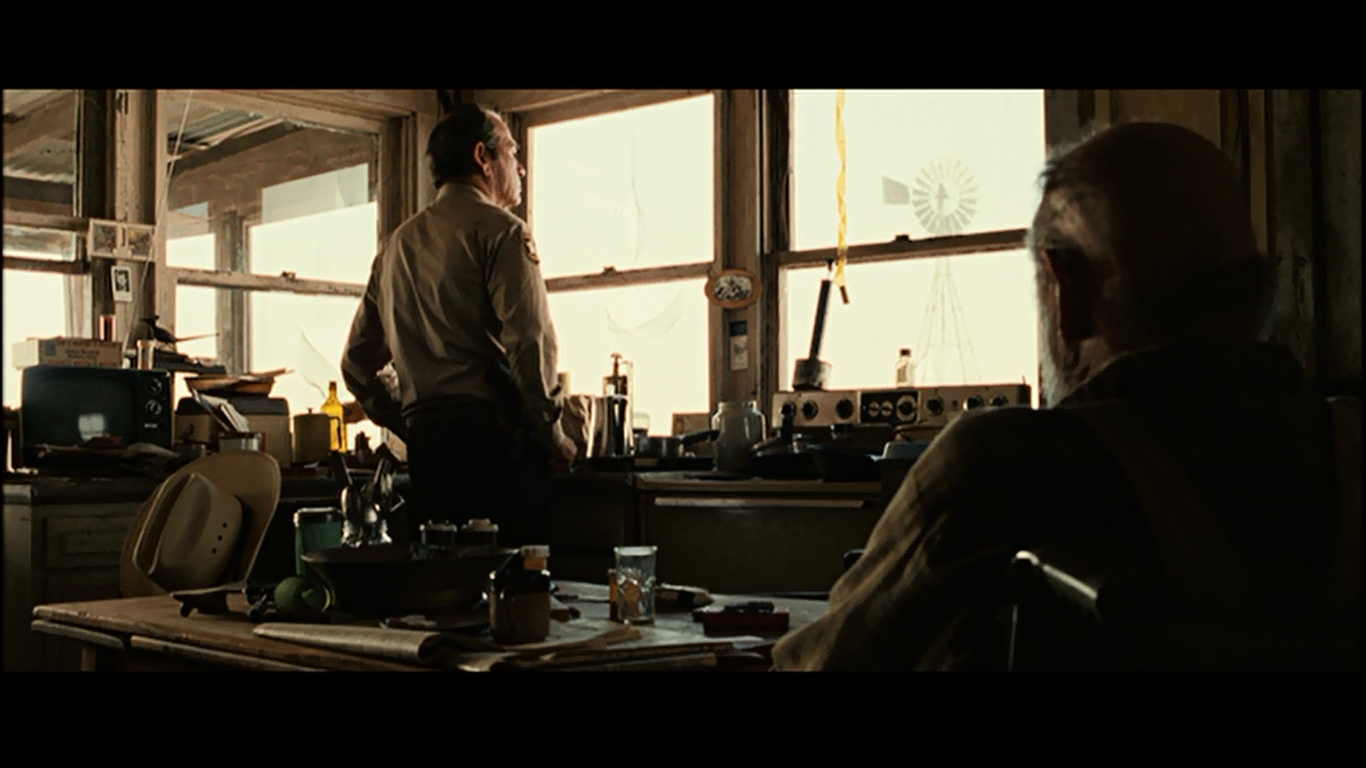
Windmill, shot 4. Looking out Ellis’s window, Bell sees a windmill much like the one showcased during Bell’s opening voice-over.
Throughout the scene, even when the windmill isn’t visible, sounds of the windmill creaking play on the soundtrack. Pascal Bonitzer, concerned with the disembodied voice’s easy assumption of power and imposition of a singular point of view, argues that one way to “compromise the voice’s inherent authority” is to “make it relate to the image-track obliquely or ironically.”[16] This is one of the ways in which the Coens undercut Bell’s power and authority: filmic motifs portray Bell as a disembodied voice of authority in the early scenes, but soon enough show that his days of power are behind him through his own words, the ironic juxtaposition of his words with the image track, and, finally, as discussed below, by embodying him over the course of the film.
Although Bell’s voice-over narration begins the film—his voice predates the image-track entirely—it is almost a half an hour until he is seen on screen; as Tasha Robinson notes, the “sudden spate of narration comes from nowhere, and isn’t immediately pinned to anyone”.[17] Silverman argues that the male subject finds “his most ideal realization when he is heard and not seen.”[18] However, after setting the tone and theme of the film, Bell’s presence takes a back seat and he is not seen until much later and he is never again heard in voice-over. His power and authority have already begun to erode, and this process will inexorably continue over the course of the film.
Throughout the course of No Country, Bell moves from an authoritative position as disembodied voice-over narrator only to end the film in an embodied monologue in which he is shown dressed in civilian clothes, talking to his wife, who tartly tells him she can’t accompany him on a ride because she’s not retired and then follows it up by telling him she doesn’t need or want his help around the house. She convinces Bell to describe his dreams from the previous night, which he finally does. This monologue ends the film.
For as long as the voice is heard and the body not seen, it has “the scope of an oracle” but the voice is “submitted to the destiny of the body” once the voice and body are reunited in synchronous sound.[19] Bell’s power and authority diminish over the course of the film as he goes from oracular disembodied voice to defeated old man, housebound and henpecked.
The fact that Bell’s description of his dreams has an audience—his wife—is a choice that the Coen brothers made; in the McCarthy novel, Bell’s final speech is italicized, marking an inner monologue, and has no audience other than the reader. It would have been a simple matter for the Coens to preserve this structure in the film and have Bell end the film with another voice-over speech. The fact that they choose not do this shows that their use of voice-over is strategic and thematically important. The narrative itself overtly shows that Sheriff Bell is incapable of continuing in his capacity as sheriff and, indeed, by the end, he has retired and is safely ensconced in the domestic realm. His voice follows the same arc, from occupying what Pascal Bonitzer calls the “voice of knowledge par excellence in all films” as a disembodied, apparently third person narrator to a voice confined to a body, mortal, frail, afraid, while the outlaw simply walks away.[20]
The lawman has not just failed or been killed by the villain; he has given up altogether and never even confronts the outlaw, an unprecedented choice for a Western. The Coens portray an iconic Western sheriff who revels in the heroic tales of the American frontier but who retreats from the field rather than confront an adversary who frightens and confounds him. By emphasizing Bell’s reverence for the “old timers” via his own heroic opening voice-over while depicting his failure through the rest of the film, the Coens show the hollowness of Westerns that purport to instruct viewers on American masculinity while really only creating unrealistic stereotypes. In this view, No Country becomes a critique of Westerns that created and continue to perpetuate the unattainable masculinity of John Wayne’s characters, such as that shown on the “Pass It On” billboard.
The Sound of Mattie in True Grit
In contrast to No Country’s stark soundtrack that features little music in order to emphasize the voice and the wind, the Coen bothers’ True Grit is filled throughout with several voice-over sections as well as with evocative and rich music. As Carter Burwell, the film’s composer and long-time Coen collaborator, points out, “The music is non-stop from the time Mattie sees Chaney, her father’s killer, until the end of the film” and, in fact, the music is an almost-constant presence.[21] By far the most prominent voice belongs to the girl protagonist, Mattie Ross, who hires Federal Marshall Rooster Cogburn to pursue her father’s killer into Indian Country. While the 1969 film adaptation of True Grit, directed by Henry Hathaway and starring John Wayne, put Cogburn at the center of the narrative, Burwell notes that the Coens put Mattie rather than Rooster at the center of the story, as Charles Portis’s novel of the same name does. In the Coens’ version, the music and Mattie’s voice work together to foreground Mattie’s world view and point of view while Rooster and LaBouef are made into supporting characters.
The choice of Mattie, a fourteen year old girl, as a protagonist for a Western film is very unusual; John Belton points out that women in Westerns are often “the forces of civilization, embodying the values of family, community, education, domestication, and cultivation that informs the male hero’s transformation of the wilderness into a garden.”[22] Mattie straddles both worlds in that she calls upon the forces of civilization freely when needed, most notably Lawyer Dagget, while still being as bent on vengeance as any male hero whose kin was killed. Lee Clark Mitchell argues that Westerns as a genre “fret over the construction of masculinity” and, from the beginning, have been “deeply haunted by the problem of becoming a man.”[23] Mattie, as a fourteen-year-old girl, is not only uninterested in masculinity, but she’s not particularly interested in being or becoming feminine either. She is, like many a Western protagonist before her, on a simple but bloody quest for justice in an environment where justice is often vigilante. Such typical Western themes, however, cannot help but look very different when carried out by a young girl; the Coens’ focus on Mattie brings this thematic material to the fore.
Mattie’s primary preoccupation is not masculinity or femininity but righteousness and a balancing of accounts. While Portis’s novel infuses Mattie’s narration with a vigorous religiosity through regular references to scripture, many asides in which Mattie comments upon religious matters of her time, and Biblical themes of grace and redemption, the Coens’ film reinforces that narration with music. As Burwell notes in his commentary on the film on his website, Mattie “doesn’t narrate the body of the film, however, and I came to think that a score based on church music would put her quest in context.” Burwell and the Coens decided on Protestant hymns from the film’s period, the late nineteenth century. Making Mattie a voice-over narrator is also an unusual choice for a Western. As Sarah Kozloff writes, “female narrators are likely to be confined to a certain domestic or personal ghetto,” generally narrating their own lives in “’women’s films,’ adaptations, and occasional noirs,” so having a woman narrate her own adventures and perspective on this most American and most masculine of genres makes it an interesting case study for genre, gender, and voice.[24]
While the hymn-based music chosen by Burwell and the Coens in some ways adheres to typical uses of film music, it also accomplishes some more subtle narrative work as well. Film music theorist Roy M. Prendergast notes that one of the main purposes of film music is to create “color,” an “atmosphere of time and place,” immediately in an audience who may be musically “unsophisticated.”[25] Musical color, Prendergast continues, is associative and immediate, unlike building musical themes and motifs, which take time, and, perhaps most importantly, musical color “is not intrusive; it does not compete with the dramatic action.”[26] This is the most apparent use of True Grit’s music, especially during the first moments of the film and during Mattie’s opening voice-over narration. The film opens with her relating the account of her father’s murder at the hands of Tom Chaney, while the score features a lone piano playing one of the most important pieces of music in the film, “Leaning on the Everlasting Arms.” The hymn first provides thematic color by implying a time and atmosphere of stark religiosity instead of high-spirited adventure and derring-do.
Eventually, over the course of the narrative, “Leaning on the Everlasting Arms” becomes the theme for Mattie and a dominant musical motif overall; Burwell estimates that the hymn features in about a quarter of the score in one form or another, and its dominance on the soundtrack reflects both Mattie’s status as main character as well as her religious and harsh outlook. Burwell notes that he did not want to use modern versions of the hymns, which he found “distinctly uninspiring.” He describes how the contemporary arrangements were meant to sound “warm, comforting, uplifting,” which was not the tone he was striving for. The West depicted in the Coens’ True Grit is not the realm for heroic cowboys and cavalrymen rescuing innocent settlers from marauding Natives, thus Burwell wanted to avoid as much as possible the use of music to “sanctify myths about the origin of the United States.”[27] So the spare piano music playing alongside Mattie’s opening voice-over narration creates an appropriate color for this particular Western by emphasizing the stark, harsh realities of life in the 1870s, especially for women and children on the frontier.
In addition to creating an appropriate atmosphere in the first few minutes of the film, “Leaning on the Everlasting Arms” is an appropriate theme for her character because, as Burwell notes, “Mattie has never seen a Hollywood Western, nor read a Western novel. Her pieties derive from her knowledge of the Bible, and her courage is really a Presbyterian self-righteousness.”[28] She is uncompromising and sure of herself, which is unusual for a girl in a Western film, a genre in which it is far more common for girls and women to be off-screen motivators for male actions, like Debbie in The Searchers or the prostitute whose cut face serves as the inciting incident of Unforgiven. Mattie faces setbacks during her quest, including the humiliation of being spanked by LaBouef for daring to cross the river in defiance of Rooster’s desire to leave her behind. Despite these obstacles, the film does not revel in degrading her or showing her as incompetent, although it does not glorify her or show her as without fault either.
To complement the hymns that dominate the musical score, Mattie’s various voice-over speeches include numerous religious references. The film begins with an epigraph from Proverbs (“The wicked flee when none pursueth”) while Mattie’s opening voice-over ends with her asserting that there is “nothing free in this world except the grace of God.” Likewise, in Mattie’s letter to her mother announcing her intention to pursue Tom Chaney alongside Cogburn, which the audience hears in voice-over, she says “though I walk through the valley of the shadow of death, I shall fear no evil. The author of all things watches over me.” Unlike many voice-over narrators who open a film and then are never heard from again, Mattie’s voice, with its religious overtones, is heard throughout the film.
Mattie’s viewpoint is never seriously challenged throughout the film, certainly not in the manner in which Sheriff Bell’s voice-over is undercut and then eliminated altogether. Silverman argues that the female subject, unlike the male, is not only denied the position of disembodied enunciator, but she is also confined “within the story,” and to positions “which come within eventual range of male vision or audition.”[29] As the primary focalizing character, the insertion of Mattie’s voice structures the film: her voice-over narration opens the film, her voice in the form of a letter read to her mother announces that the great adventure has begun and moves the narrative to Indian Country, and her voice-over reflection closes the film.
Despite this, though, the audience hears two other characters in voice-over as well, both of which challenge or scold Mattie. But instead of including multiple voice-over narrators that disempower or dilute Mattie’s voice, the Coens use these secondary speakers to showcase her fortitude and certainty. The first is her much-called-upon lawyer, J. Nobel Dagget, who writes in response to Mattie’s horsetrading with Colonel Stonehill. Mattie strategically deploys Dagget’s name throughout her dealings with Stonehill (and others), calling upon his authority to back hers. Despite this, it is clear that it is Mattie and her shrewd dealing that gets the best of Stonehill. When Dagget writes to her, he claims he isn’t “scolding” Mattie, but clearly he is, even as he realizes this is a useless gesture. He warns that her “headstrong ways” will get her into trouble one day, which they do, and he expresses his “wish” that she would leave such business matters to him, even though he knows she will not. In the end, he backs her and provides the legal document that she needs to conclude her trading which finances the pursuit of Chaney. Although Dagget concludes his letter by indicating that he has enclosed the legal document so that she may finish her business and return home, Mattie simply disregards this and continues as she sees fit. Dagget, though he is a disembodied voice-over narrator, is simply no match for Mattie, teenage girl though she may be. Rather than a typical male voice-over narrator who speaks from off screen and thus cannot be questioned, Dagget is but a means to Mattie’s ends and his voice is simply ignored.
In addition to Dagget, the other voice heard in voice-over is Cogburn’s, also in a letter that he narrates to the audience; unlike Lawyer Dagget, Cogburn does not take Mattie’s personality or wishes into account. Cogburn, for his part, is as bald and blunt as Dagget is careful and indirect. Whereas Dagget opens and closes his letter by addressing Mattie and then signing himself, “Yours, J. Nobel Dagget,” Cogburn simply writes his orders bluntly: “Here inside is a train ticket for your return home. Use it.” He also thinks he has presented her with a fait accompli by telling her to meet him at 7AM, by which time he has already crossed the river into Indian Country; “pursuit would be futile” he tells her, and he closes by ordering her to leave him to his work.
Despite the differences between Cogburn and Dagget, Mattie’s response is the same; she simply does as she will. Pascal Bonitzer notes that one way to undercut the power and authority of a voice-over narrator is to “multiply it”; he notes that including multiple voice-over narrators dilutes the power and authority accorded any one of them.[30] This is not true in True Grit, however, because Mattie does not pay the smallest bit of attention to the orders given to her in the letters presented in voice-over despite the fact that both are narrated by older, authoritative male characters. Mattie quite simply ignores Cogburn’s orders, as she ignored Dagget’s implied instructions, and heads to the river, where she demands the ferryman take her across to Cogburn, who is only now on the other side of the river. Cogburn anticipated this, though, and left orders for the ferryman to take Mattie, whom he has labelled a “runaway,” to the sheriff. Mattie, as always, is resourceful and stubborn. After distracting the man with a thrown apple, she gallops her horse into the river and they swim across where she finds that Cogburn and LaBouef have joined forces.
As Mattie goes on her “coon hunt,” as Cogburn calls it, the film’s music changes. From the hymns that evoke Mattie’s sense of Presbyterian righteousness at the start the film, the music evolves thematically into an orchestral score more typical for a Western at the moment when Mattie joins Cogburn and LaBouef across the river. This change includes the typical brass, strings, and timpani usually associated with the Western score as Mattie plunges with her ill-fated pony, Blackie, across the river into Indian Territory, defying all the “voices” in the first act of the film. It is at this point that the manhunt truly gets underway. The theme that accompanies Mattie’s surprise river crossing is a melody called “Your Headstrong Ways,” titled, of course, after Lawyer Dagget’s prophetic admonishment in his letter (“Your headstrong ways will lead you into a tight corner one day”). As she follows Cogburn and LaBouef into Indian Country, the music becomes less hymn-like in order to convey Mattie’s moving away from the known and familiar to things beyond her experience. Additionally, the film’s music becomes more traditionally “Western” by using a bigger sound with more brass and percussion, as in the river crossing as well as the shootout between Cogburn, LaBouef, and the Ned Pepper gang.
At the film’s climax, the music once again changes and defies expectation. Moviegoers might expect a big, orchestral score to represent the urgency and high stakes of Cogburn’s race to save Mattie’s life after she has been bitten by a rattlesnake. The music at this point in the 1969 Henry Hathaway version of True Grit was all those things. In contrast, though, the Coens and Burwell decided to revise Mattie’s theme, “Leaning on the Everlasting Arms”; even when the narrative focuses on Cogburn’s heroics, the narrative itself reflects Mattie’s perspective and her character’s development. The hymn, slow and spare as ever, performed upon a lone piano, plays as Cogburn carries Mattie to the doctor, riding her beloved pony Blackie to the point that the animal must be put down. Blackie’s mercy killing is a terrible scene, for both characters and audience, and illuminates the theme of self-sacrifice that undergirds the action of the narrative. After Blackie’s death, the music plays a dirge for him by returning to the theme of his and his mistresses’ most triumphant moment together, the river crossing, although in a much darker tone and slower tempo.
Rather than focus on the defeat and punishment of Chaney and the sparing of both Cogburn and LaBouef, the music asks the audience to ruminate on the cost of Mattie’s adventure: she did avenge her father, but LaBeouf is seriously injured, Blackie was run to death, she herself is on death’s doorstep and soon to lose an arm to snake venom, and a number of men have lost their lives during her quest for revenge. While revenge is a central theme in many Westerns, True Grit uses music to highlight the cost of vengeance to both hunter and hunted and to consider the role Mattie’s religious certainty played in her pursuit of vengeance. Mattie’s bloodthirstiness and relentless quest for vengeance would seem natural for a Western film starring an aggrieved male hero whose kin, probably female, have been violated, kidnapped, killed, or all three. However, by putting typical Western vengeance sentiments into the voice of a fourteen-year-old girl, the Coens highlight the actual philosophy being espoused. The choice of music asks the audience to consider the price of Mattie’s certainty of the righteousness of her quest and her belief that all accounts can be and must be paid. While Mattie’s opening voice-over asserts that nothing is free in this world except the grace of God, Cogburn saved her life and wanted nothing in return. He left her bedside once she was out of danger and, despite her invitation, never came to collect the fifty dollars she owed him. In Portis’s novel, Mattie mails Cogburn a check, so the fact that the Coens explicitly state that he never collected the money due him emphasizes their refutation of Mattie’s early assertion that nothing is free.
As a bookend to her opening voice-over, Mattie’s voice once again comes to the forefront in the final few minutes of the film. In order to reinforce the mirroring of the opening, the image track is also similar to the beginning few minutes. After the fade to black, the next image depicts a woman riding in a train, looking out the window as the signage for the station name is seen passing by backwards in the window’s reflection, much as young Mattie first arrived in Fort Smith. As the image track shows Mattie arriving in Memphis on the train, her voice is once again heard in voice-over, first noting that a “quarter of a century is a long time.” While it was Cogburn’s and Blackie’s efforts and sacrifices that were emphasized during the climatic sequence, it is still Mattie’s story and thus it is her voice that concludes her tale, drawing her own conclusions.
The short coda shows how Cogburn’s voice, story, and even his earthly remains were appropriated by others with varying motivations; like Sheriff Bell from No Country, Cogburn is displaced from the Western narrative. Cogburn’s story had already been usurped by the narrative told by the Wild West show he was involved with, which used and manipulated his persona and story for profit. This aspect is not played up by the film, but can be seen in the final minutes. First, the flyer that Cogburn sent to Mattie claims that Cogburn will “amaze you with his skill and dash.” Cogburn, as Mattie and the audience well know by this point, is hardly dashing, especially considering, as Cogburn himself says in his note to Mattie, that he’s only grown “older and fatter” over the years. Also, as Mattie walks through the show to speak with its owners, she passes by a number of large posters that show romanticized stereotypes of the “old West.” The story told by the posters and, presumably by the show they advertise, bears little resemblance to the Western story related in True Grit. More interesting, though, is how Mattie herself takes control of Cogburn’s voice and, finally, even his bones. Much of her final voice-over ventriloquizes Cogburn’s written invitation to meet him in Memphis and “swap stories with an old trailmate.” Even more pointedly, Mattie freely critiques Cogburn’s written expressions both times she receives them.
John Belton notes that representations of women in Westerns are often “conventional and secondary,” and that they usually serve as “agents of easternization” on the wild and untamed men and frontier; Mattie in True Grit is quite different.[31] The mirroring between the beginning and the ending of the film—both in Mattie’s voice-over and in the similar images of Mattie’ arriving in a train—implies that she is unchanged by the events depicted and that the narrative has come full circle. She remains bent on vengeance.
Conclusion
The most common themes critics address in the work of the Coen brothers are “the fascination of language, the application of postmodern techniques, attention to regionalism and charges of arrogant superiority.”[32] One of the few monographs devoted to the Coen brothers, R. Barton Palmer’s Joel and Ethan Coen, focuses almost entirely on their relationship to postmodernism.[33] While much of the criticism of the Coens as auteurs has been quite favorable, there were early commenters who found the Coens’ work sterile or glib, little more than genre play and visual gimmicks. Both No Country and True Grit, however, deal subtly with issues of gender and voice and do valuable work in decentering the version of masculinity that has remained at the center of representations of the American West for too long. In No Country, it is not merely a sheriff’s voice that is disempowered, but it is the voice of Tommy Lee Jones, an iconic leading man known for his roles in countless Westerns as well as films like U.S. Marshals, The Fugitive, and Men in Black, films that center on Jones as the authoritative and stoic enforcer of the law. Likewise, by making True Grit Mattie’s story instead of Cogburn’s, the Coens offer a corrective to the earlier version, which preferred John Wayne as the lead instead of Kim Darby, who played Mattie as a secondary character. When we focus our attention on the innovative uses of sound in these two films, we recognize that they offer much more than mere postmodernist genre play; in fact, they participate in a new cycle of revisionist Westerns that critique traditional gender roles and invite the audience to reflect critically on this crucial American genre.
Laura L. Beading earned her doctorate in American Studies from Purdue University in 2007. She currently teaches film, literature, and screenwriting at Youngstown State University in Ohio.
Notes
[1] Values.com, http://www.values.com/
[2] Jeremy David Stolen, “Big Money Behind ‘Inspirational’ Billboard Campaign,” The Portland Alliance, 2002, http://www.theportlandalliance.org/2002/april/billboard.html.
[3] Susanne Kord and Elisabeth Krimmer, Contemporary Hollywood Masculinity: Gender, Genre, and Politics (New York: Palgrave Macmillan, 2011).
[4] Russell Meeuf, John Wayne’s World: Transnational Masculinity in the Fifties (Austin: University of Texas Press, 2013).
[5] Andrew Spicer, Typical Men: The Representation of Masculinity in Popular British Cinema (New York: I.B. Tauris, 2001).
[6] J. M. Tyree and Ben Walters, The Big Lebowski (London: BFI Film Classics, 2007).
[8] R. Barton Palmer, Joel and Ethan Coen (Urbana: University of Illinois Press, 2004), 12.
[9] Allen H. Redmon, “How Many Lebowskis Are There: Genre, Spectatorial Authorship, and The Big Lebowski,” Journal of Popular Film and Television 40.2 (2012): 55, 59.
[10] William J. Devlin, “No Country for Old Men: The Decline of Ethics and the West(ern),” in The Philosophy of the Western, eds. Jennifer L. McMahon and B. Steve Csaki (Lexington: University of Kentucky Press, 2010), 222.
[11] Camilla Fojas, “Hollywood Border Cinema: Westerns with a Vengeance,” Journal of Popular Film and Television 39.2 (2011): 93-101, 99.
[12] Sonya Topolnisky, “For Every Tatter in Its Mortal Dress: Costumes and Character in No Country for Old Men,” in No Country for Old Men: From Novel to Film, eds. Lynnea Chapman King, Rick Wallace, and Jim Welsh (Lanham, MD: Scarecrow, 2009), 110-123. 111.
[13] Kaja Silverman, The Acoustic Mirror: The Female Voice in Psychoanalysis and Cinema (Bloomington, IN: Indiana University Press, 1998), ix.
[15] Mary Ann Doane, “The Voice in the Cinema: The Articulation of Body and Space,” Yale French Studies 60 (1980): 42.
[16] Pascal Bonitzer, “The Silences of the Voice,” in Narrative, Apparatus, Ideology, ed. Philip Rosen (New York: Columbia University Press, 1986), 322.
[17] Tasha Robinson, “Book vs. Film: No Country for Old Men,” A. V. Club, November 27, 2007. http://www.avclub.com/article/book-vs-film-ino-country-for-old-meni-10236
[18] Silverman, 164.
[19] Doane, 323.
[20] Bonitzer, 322.
[21] Carter Burwell, “True Grit: Carter Burwell’s Notes,” Carter Burwell, January 11, 2015. http://www.carterburwell.com/projects/True_Grit.shtml.
[22] John Belton, American Cinema/American Culture 2nd ed. (New York: McGraw-Hill, 1994), 251.
[23] Lee Clark Mitchell, Westerns: Making the Man in Fiction and Film (Chicago: University of Chicago Press, 1996), 4.
[24] Sarah Kozloff, Invisible Storytellers: Voice-Over Narration in American Fiction and Film (Berkeley, CA: University of California Press, 1988), 100.
[25] Roy M. Prendergast, Film Music: A Neglected Art (London: W. W. Norton, 1992), 213-14.
[26] Prendergast, 214.
[27] Burwell.
[28] Burwell.
[32] Paul Couglin, “Joel and Ethan Coen,” Senses of Cinema, May 2003, Issue 26. http://sensesofcinema.com/2003/great-directors/coens/.
[33] R. Barton Palmer, Joel and Ethan Coen (Champaign-Urbana, U of Illinois P, 2004).

